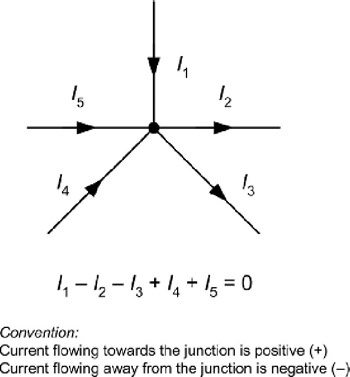Kirchhoff's laws simply deal with voltage drops and rises with the current flowing in a circuit by using the ideas of simple energy conservation. These laws are very helpful in determining of the output response for network analysis.
KIRCHHOFF'S LAW:
- Kirchhoff's Voltage law(KVL): The algebraic sum of all branch voltages around any closed loop of a network is zero at all instants of time.
 Mathematically kvl can be written as, [tex]\sum {V = 0} [/tex]
Mathematically kvl can be written as, [tex]\sum {V = 0} [/tex] - Kirchhoff's Current law(KCL): The algebraic sum of the branch currents at a node is zero at all instants of time.

Mathematically kcl maybe written as, [tex]\sum {i = 0} [/tex]
Based on KVL and KCL we can write the loop and node equations respectively.
Example: Let us take a circuit and referring the circuit node and loop equations are written,
Node A Node B

We have three loops and the currents in the elements are as specified. By KVL, we get
[tex]{I_1}{R_1} + ({I_1} - {I_2}){R_2} = {V_1}[/tex]
[tex]({I_2} - {I_1}){R_2} + {I_2}{R_3} + ({I_2} - {I_3}){R_4} = 0[/tex]
[tex]({I_3} - {I_2}){R_4} + {I_3}{R_5} = {V_2}[/tex]
Similarly using KCL,the node equations can be written as:
Taking voltage of node A is [tex]{V_A}[/tex] and voltage of node B is[tex]{V_B}[/tex]
[tex]\frac{{({V_A} - {V_1})}}{{{R_1}}} + \frac{{{V_A}}}{{{R_2}}} + \frac{{({V_A} - {V_B})}}{{{R_3}}} = 0[/tex]
[tex]\frac{{({V_B} - {V_A})}}{{{R_3}}} + \frac{{{V_B}}}{{{R_4}}} + \frac{{({V_B} - {V_2})}}{{{R_5}}} = 0[/tex]







